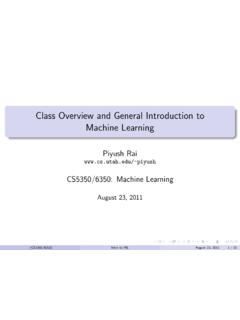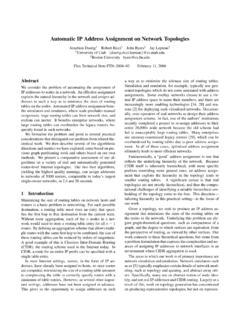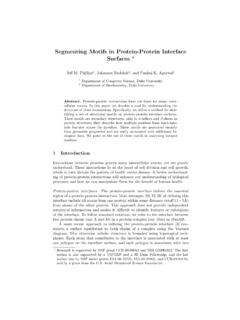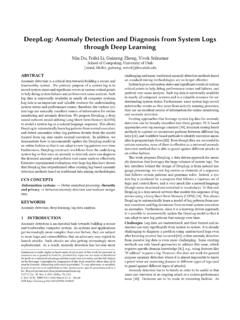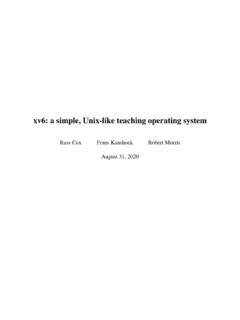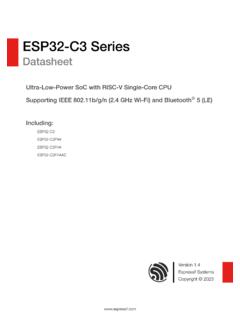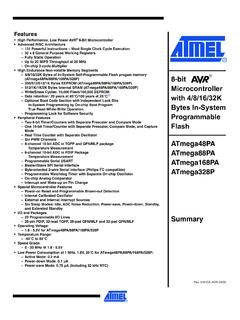Transcription of Lecture 5: MIPS Examples
1 1 Lecture 5: MIPS Examples Today s topics: the compilation process full example sort in C Reminder: 2ndassignment will be posted later today2 Dealing with Characters Instructions are also provided to deal with byte-sizedand half-word quantities: lb (load-byte), sb, lh, sh These data types are most useful when dealing withcharacters, pixel values, etc. C employs ASCII formats to represent characters eachcharacter is represented with 8 bits and a string ends inthe null character (corresponding to the 8-bit number 0)3 ExampleConvert to assembly:void strcpy (char x[], char y[]){int i;i=0;while ((x[i] = y[i]) != `\0 )i += 1;}4 ExampleConvert to assembly:void strcpy (char x[], char y[]){int i;i=0;while ((x[i] = y[i]) !)}
2 = `\0 )i += 1;}strcpy:addi $sp, $sp, -4sw $s0, 0($sp)add $s0, $zero, $zeroL1: add $t1, $s0, $a1lb $t2, 0($t1)add $t3, $s0, $a0sb $t2, 0($t3)beq $t2, $zero, L2addi $s0, $s0, 1j L1L2: lw $s0, 0($sp)addi $sp, $sp, 4jr $ra5 Large Constants Immediate instructions can only specify 16-bit constants The lui instruction is used to store a 16-bit constant intothe upper 16 bits of a thus, two immediateinstructions are used to specify a 32-bit constant The destination PC-address in a conditional branch isspecified as a 16-bit constant, relative to the current PC A jump (j) instruction can specify a 26-bit constant; if morebits are required, the jump-register (jr) instruction is used6 Starting a ProgramC ProgramAssembly language programObject: machine language moduleObject: library routine (machine language)Executable: machine language , of Assembler Convert pseudo-instructions into actual hardwareinstructions pseudo-instrs make it easier to programin assembly Examples : move , blt , 32-bit immediateoperands, etc.
3 Convert assembly instrs into machine instrs a separateobject file ( ) is created for each C file ( ) computethe actual values for instruction labels maintain infoon external references and debugging information8 Role of Linker Stitches different object files into a single executable patch internal and external references determine addresses of data and instruction labels organize code and data modules in memory Some libraries (DLLs) are dynamically linked theexecutable points to dummy routines these dummyroutines call the dynamic linker-loader so they canupdate the executable to jump to the correct routine9 Full Example Sort in C Allocate registers to program variables Produce code for the program body Preserve registers across procedure invocationsvoid sort (int v[], int n){int i, j;for (i=0; i<n; i+=1) {for (j=i-1; j>=0 && v[j] > v[j+1]; j-=1) {swap (v,j);}}}void swap (int v[], int k){int temp;temp = v[k];v[k] = v[k+1];v[k+1] = temp;}10 The swap Procedure Allocate registers to program variables Produce code for the program body Preserve registers across procedure invocationsvoid swap (int v[], int k){int temp.}
4 Temp = v[k];v[k] = v[k+1];v[k+1] = temp;}11 The swap Procedure Register allocation: $a0 and $a1 for the two arguments, $t0 for thetemp variable no need for saves and restores as we re not using$s0-$s7 and this is a leaf procedure (won t need to re-use $a0 and $a1)swap: sll $t1, $a1, 2add $t1, $a0, $t1 lw $t0, 0($t1) lw $t2, 4($t1) sw $t2, 0($t1) sw $t0, 4($t1)jr $ravoid swap (int v[], int k){int temp;temp = v[k];v[k] = v[k+1];v[k+1] = temp;}12 The sort Procedure Register allocation: arguments v and n use $a0 and $a1, i and j use$s0 and $s1for (i=0; i<n; i+=1) {for (j=i-1; j>=0 && v[j] > v[j+1]; j-=1) {swap (v,j);}}13 The sort Procedure Register allocation: arguments v and n use $a0 and $a1, i and j use$s0 and $s1; must save $a0, $a1, and $ra before calling the leafprocedure The outer for loop looks like this: (note the use of pseudo-instrs)move $s0, $zero # initialize the looploopbody1: bge $s0, $a1, exit1 # will eventually use slt and body of inner loop.
5 Addi $s0, $s0, 1j loopbody1exit1: for (i=0; i<n; i+=1) {for (j=i-1; j>=0 && v[j] > v[j+1]; j-=1) {swap (v,j);}}14 The sort Procedure The inner for loop looks like this:addi $s1, $s0, -1 # initialize the looploopbody2: blt $s1, $zero, exit2 # will eventually use slt and beqsll $t1, $s1, 2add $t2, $a0, $t1lw $t3, 0($t2)lw $t4, 4($t2)bge $t4, $t3, body of inner loop ..addi $s1, $s1, -1j loopbody2exit2: for (i=0; i<n; i+=1) {for (j=i-1; j>=0 && v[j] > v[j+1]; j-=1) {swap (v,j);}}15 Saves and Restores Since we repeatedly call swap with $a0 and $a1, we begin sort bycopying its arguments into $s2 and $s3 must update the rest of thecode in sort to use $s2 and $s3 instead of $a0 and $a1 Must save $ra at the start of sort because it will get over-written whenwe call swap Must also save $s0-$s3 so we don t overwrite something that belongsto the procedure that called sort 16 Saves and Restoressort: addi $sp, $sp, -20sw $ra, 16($sp)sw $s3, 12($sp)sw $s2, 8($sp)sw $s1, 4($sp)sw $s0, 0($sp)move $s2, $a0move $s3, $ $a0, $s2 # the inner loop body starts heremove $a1, $s1jal : lw $s0, 0($sp).
6 Addi $sp, $sp, 20jr $ra9 lines of C code 35 lines of assemblyfor (i=0; i<n; i+=1) {for (j=i-1; j>=0 && v[j] > v[j+1]; j-=1) {swap (v,j);}}17 Relative PerformanceGcc optimization Relative Cycles Instruction CPIperformance countnone 159B 115B 67B 37B 67B 40B 66B 45B A Java interpreter has relative performance of , while theJave just-in-time compiler has relative performance of Note that the quicksort algorithm is about three orders ofmagnitude faster than the bubble sort algorithm (for 100K elements)
7 18IA-32 Instruction Set Intel s IA-32 instruction set has evolved over 20 years old features are preserved for software compatibility Numerous complex instructions complicates hardwaredesign (Complex Instruction Set Computer CISC) Instructions have different sizes, operands can be inregisters or memory, only 8 general-purpose registers,one of the operands is over-written RISC instructions are more amenable to high performance(clock speed and parallelism) modern Intel processorsconvert IA-32 instructions into simpler micro-operations19 Title Bullet
